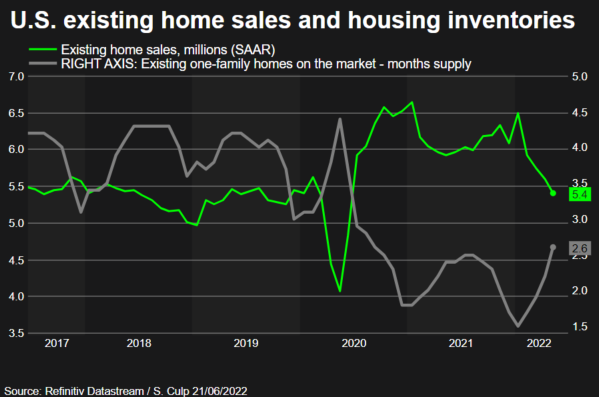Advertisement
Advertisement
U.S. home sales slide as prices break above $400,000 for first time
By:
WASHINGTON (Reuters) - U.S. existing home sales tumbled to a two-year low in May as prices jumped to a record high - topping the $400,000 mark for the first time - and as mortgage interest rates increased further, sidelining first-time buyers from the market.
By Lucia Mutikani
WASHINGTON (Reuters) – U.S. existing home sales tumbled to a two-year low in May as prices jumped to a record high – topping the $400,000 mark for the first time – and mortgage rates increased further, pushing out entry-level buyers from the market.
Despite the fourth straight monthly drop in sales and declining affordability, reported by the National Association of Realtors on Tuesday, the housing market remains fairly hot, with properties typically staying on the market for a record low 16 days. With supply still undesirably low, prices could remain elevated, though sellers are reducing the list price in some areas where bidding wars were prevalent.
“Existing home sales should continue to slow over the course of the year as mortgage rates move higher,” said David Berson, chief economist at Nationwide in Columbus, Ohio. “But in the absence of a deep and sustained economic downturn, home sales should not drop as they did in the housing bust – allowing prices to continue to move higher on average.”
Existing home sales fell 3.4% to a seasonally adjusted annual rate of 5.41 million units last month, the lowest level since June 2020 when sales were rebounding from the COVID-19 lockdown slump. Sales rose in the Northeast, but declined in the Midwest, the West and densely populated South.
Economists polled by Reuters had forecast sales would decrease to a rate of 5.40 million units. They estimate that a housing market downturn would need sales to drop to between a rate of 4.0 million to 4.5 million.
Home resales, which account for the bulk of U.S. home sales, tumbled 8.6% on a year-on-year basis last month.
Sales in May were mostly closings on contracts signed one to two months ago, before mortgage rates started accelerating amid a surge in inflation expectations and the Federal Reserve’s aggressive interest rate hikes.

The average contract rate on a 30-year fixed-rate mortgage jumped 55 basis points last week to a 13-1/2-year high of 5.78%, according to data from mortgage finance agency Freddie Mac. That was the largest one-week increase since 1987. The rate has surged more than 250 basis points since January.
The report joined housing starts, building permits and homebuilder sentiment in suggesting that the housing market was losing speed under the weight of higher borrowing costs. It was also the latest indication that the U.S. central bank’s rapid monetary policy tightening was slowing the overall economy.
That was underscored by a separate report from the Chicago Fed on Tuesday showing its National Activity Index fell to a reading of 0.01 in May from 0.40 in April, which it said “suggests economic growth declined in May.”
A zero value for the monthly index has been associated with the economy expanding at trend growth. Fears of a recession have been mounting in the wake of the Fed’s decision last week to raise its policy rate by three-quarters of a percentage point, its biggest hike since 1994.
The Fed has increased its benchmark overnight interest rate by 150 basis points since March.
U.S. stocks on Wall Street rebounded on Tuesday from recent sharp losses. The dollar fell against a basket of currencies. U.S. Treasury yields rose.
Slowing migration
The housing market is the sector most sensitive to interest rates. Its slowdown could help to bring housing supply and demand back into alignment and slow price growth.
The median existing house price raced 14.8% from a year earlier to an all-time high of $407,600 in May, crossing the $400,000 level for the first time.
The $250,000-$500,000 price bracket accounted for 42.0% of the houses sold last month, with the $500,000-$750,000 segment making up 19.3%. Only 19.5% of the homes sold were in the sought-after $100,000-$250,000 price range. Double-digit price growth was registered in the South and West.
But the pandemic-driven migration to some areas in the South is slowing, which could help tame the price appreciation.
“The affordability migration will lose some steam now that interest rates have risen, which will make it a bit tougher to sell homes in those higher-price markets,” said Mark Vitner, a senior economist at Wells Fargo in Charlotte, North Carolina.
There were 1.16 million previously owned homes on the market, following a seasonal monthly bump of 12.6%. Supply remained 4.1% down year-on-year.
The steady monthly improvement could continue, with government data last week showing housing completions in May increased to the highest level since 2007.
At May’s sales pace, it would take 2.6 months to exhaust the current inventory of existing homes, up from 2.5 months a year ago. A six-to-seven-month supply is viewed as a healthy balance between supply and demand. Eighty-eight percent of homes sold in May were on the market for less than a month.
First-time buyers accounted for just 27% of sales, which economists said also explained why double-digit home price growth persists even as discounts become more common. All-cash sales made up 25% of transactions – those are mostly Wall Street institutions taking advantage of the rising demand for renting.
(Reporting by Lucia Mutikani; Editing by Dan Burns and Paul Simao)
About the Author
Reuterscontributor
Reuters, the news and media division of Thomson Reuters, is the world’s largest international multimedia news provider reaching more than one billion people every day. Reuters provides trusted business, financial, national, and international news to professionals via Thomson Reuters desktops, the world's media organizations, and directly to consumers at Reuters.com and via Reuters TV. Learn more about Thomson Reuters products:
Advertisement
